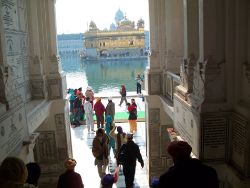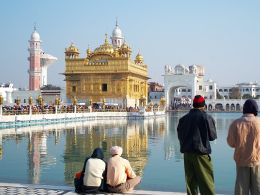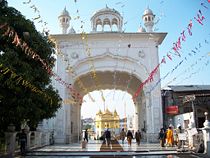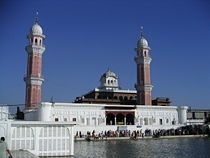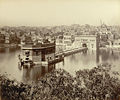Difference between revisions of "Harmandir Sahib" - New World Encyclopedia
John Gomis (talk | contribs) |
John Gomis (talk | contribs) |
||
| Line 147: | Line 147: | ||
==See also== | ==See also== | ||
| − | |||
==Notes== | ==Notes== | ||
Revision as of 19:40, 5 July 2008
The Harmandir Sahib [1](Punjabi: ਹਰਿਮੰਦਰ ਸਾਹਿਬ) or Darbar Sahib[2] (Punjabi: ਦਰਬਾਰ ਸਾਹਿਬ ), informally reffered to as The Golden Temple or Temple of God,[3] is culturally the most significant shrine of the Sikhs and one of the oldest Sikh gurudwara. It is located in the city of Amritsar, which was established by Guru Ram Das, the fourth guru of the Sikhs and is known as "guru di nagri" meaning city of the Sikh Guru.
| Harmandir Sahib | |
| Building information | |
|---|---|
| Location | Amritsar |
| Country | India |
| Architect | Guru Arjan Dev |
| Client | Guru Arjan Dev & Sikhs |
| Construction start date | December 1585 C.E. |
| Completion date | August 1604 C.E. |
| Style | Sikh architecture |
| Part of a series on Sikhism |
|
|
History of Sikhism | |
|
The Sikh Gurus | |
|
Sikh Bhagats | |
|
Other Important People | |
|
Philosophy | |
|
Sikh practices · List | |
|
Scripture | |
|
Categories |
|
|
Articles on Sikhism |
Introduction
General
The Harmandir Sahib is considered holy by Sikhs because the eternal Guru of Sikhism, the Sri Guru Granth Sahib, is always present inside in it and its construction was mainly intended to build a place of worship for men and women from all walks of life and all religion to come and worship God equally. [4][5] The Sri Guru Granth Sahib is the holiest literature in the Sikh religion [6], the tenth Guru of Sikhism, Guru Gobind Singh on 7th October 1708 made it the eternal Sikh Guru and the leader of Sikhism. [7] Anywhere in the world where the Guru Granth Sahib is present is equally holy and precious to Sikhs. Amritsar is the location of Harmandir Sahib.
History
Its name literally meaning, House of God. The fourth Guru of Sikhism, [Guru Ram Das], excavated a tank in 1577 C.E. which subsequently became known as Amritsar (meaning: Pool of the Nectar of Immortality) [8], giving its name to the city that grew around it. In due course, a splendid Sikh edifice, Harmandir Sahib (meaning: The abode of God) [9], rose in the middle of this tank and became the supreme centre of Sikhism. Its sanctum came to house the Adi Granth comprising compositions of Sikhi Gurus and other saints considered to have Sikh values and philosophies e.g. Baba Farid, Kabir, etc. The compilation of the Adi Granth was started by the fifth Guru of Sikhism, Guru Arjan Dev.
The Amritsar area
Amritsar is located in the Majha region of the Punjab. Majha is also known as the Bari Doab, since it is the Doab (Do = two, ab = rivers) or the (fluvial) tract of land which lies between two of the five great rivers of the province, the Ravi and the Beas. As such, Majha lies in the heart of the ancient Punjab region, comprised of Gurdaspur, Batala and Tarn Taran Sahib as well as Amritsar.
Construction of the Harmandir Sahib
Originally built during 1574 C.E., the site of the temple was surrounded by a small lake in a thin forest. The third of the six grand Mughals, emperor Akbar, who visited the third Sikh Guru, Guru Amar Das, at the neighbouring town of Goindval was so impressed by the way of life in the town that he gave a jagir (the land and the revenues of several villages in the vicinity) to the Guru's daughter Bhani as a gift on her marriage to Bhai Jetha, who later became the fourth Sikh Guru, Guru Ram Das. Guru Ram Das enlarged the lake and built a small township around it. The town was named after Guru Ram Das as "Guru Ka Chak", "Chak Ram Das" or "Ram Das Pura".
During the leadership of the fifth Guru, Guru Arjan Dev (1581-1606), the full-fledged Temple was built. In December 1588 the great Muslim Sufi saint of Lahore, Hazrat Mian Mir, who was a close friend of Guru Arjan Dev Ji, initiated the construction of the temple by laying the first foundation stone (December 1588 C.E.).[10][11] A mason then straightened the stone but Guru Arjan Dev told him that, as he had undone the work just completed by the holy man, a disaster might come to the Harmandir Sahib. It was later attacked by the Mughals.
The temple was completed in 1604. Guru Arjan Dev, installed the Guru Granth Sahib in it and appointed Baba Buddha Ji as the first Granthi (Reader) of it on August 1604 C.E. In the mid 18th century it was attacked by the Afghans, by one of Ahmed Shah Abdali's Generals, Jahan Khan, and had to be substantially rebuilt in the 1760s. However, in response a Sikh Army was sent to hunt down the Afghan force. They were under orders to show no mercy and historical evidence suggests none was shown. Both forces met each other 5 miles outside Amritsar; Jahan Khan's army was destroyed.[12] He himself was decapitated by commander Sardar Dayal Singh.[13]
The Harmandir Sahib Complex and areas in its vicinity
The temple is surrounded by a large lake of water, known as the Sarovar which consists of Amrit (Holy Water or Immortal Nectar). There are four entrances to the temple, signifying the importance of acceptance and openness; ostensibly, this concept is reminiscent of the tent of Abraham in the Old Testament—his tent was open on all four sides in order to be able to welcome travelers from all directions. Inside the temple complex there are many shrines to past Sikh Gurus, Saints and martyrs (see map). There are three holy trees (Bers) each signifiying a historical event or Sikh saint. Inside the temple there many memorial plaques that commemorate past Sikh historical events, saints, martyrs and includes commemorative inscriptions of all the Sikh soldiers who died fighting in World wars one and two. For a new visitor the first recommended place to visit is the information Office highlighted in the map and followed by visiting the Sikh Central museum near the main entrance and clock tower. Anyone who wants to enter the Harmandir Sahib may do so, irrespective of religion, colour, creed or sex. The only restrictions are that the person must not drink alcohol, eat meat or smoke cigarettes or other drugs while in the shrine. Visitors are, as well, expected to dress appropriately and everyone must cover their heads as a sign of respect, remove their shoes and wash their feet in the small pool of water as they enter the Harmandir Sahib premises. Head scarves are provided. All Sikh temples (Gurdwaras) in the world follow this traditional rule that everyone is welcome to enter. There are four doors to get into the Harmandir Sahib, meaning that Harmandir sahib is open to anyone.
In 1988, after Operation Black Thunder, a narrow peripheral strip of land (including buildings) was acquired by the government essentially to create a security belt. A large number of people were displaced and rehabilitated in the process.
However, the project met with a strong resistance from the moderate as well as militant Sikh organisations and the project had to be abandoned, after a senior Government engineer, connected with the project, was killed. The project was revived only in 1993 by the Deputy Commissioner Karan Bir Singh Sidhu, who was also appointed as the Project Director of what was popularly described as the Galliara Project. He changed the concept of the periphery from that of a security belt to that of a second parikarma and created a serene landscape that was fully consistent with the ethereal beauty of the Harmandir Sahib. This was done in quiet consultation with the SGPC. The pilgrims today can travel by foot in the Galliara; no vehicles are permitted.
Artwork and monument sculptures
Much of the present decorative gilding and marblework dates from the early 1800s. All the gold and exquisite marble work were conducted under the patronage of Hukam Singh Chimni and Emperor Ranjit Singh, Maharaja of the Sikh Empire of the Punjab. The Darshani Deorhi Arch stands at the beginning of the causeway to the Harmandir Sahib; it is 202 feet (62 m) high and 21 feet (6 m) in width. The gold plating on the Harmandir Sahib was begun by Emperor Ranjit Singh and was finished in 1830 C.E. The Sher-e-Punjab (Lion of the Punjab), was a heavy donor of wealth and materials for the shrine and is remembered with much affection by the Punjabi people in general and the Sikh community in particular. Maharaja Ranjit Singh also built two of the other most sacred temples in Sikhism. This was due to Maharaja Ranjit Singh having a deep love for the tenth Guru of Sikhism Guru Gobind Singh. The other two most sacred temples in Sikhism, which he built, are Takht Sri Patna Sahib (intiation or birth place of Guru Gobind Singh) and Takht Sri Hazur Sahib the place of Guru Gobind Singh's Sikh ascension into heaven.
In film and television
- The Temple is one of the locations of the movie Gandhi (1982).
- The Temple is one of the locations of Bride and Prejudice (2004).
- The Temple is also one of the places visited by the BBCs Michael Palin for the documentary 'Himalaya' (2004).
- The Temple is also in the Indian (Hindi) serial Jassi Jaissi Koi Nahin (2005).
- The Temple is a highlight in the Bollywood movies Rang De Basanti starring Aamir Khan (2006).
- The Temple is one of the locations of Namastey London (2007).
Notable visits
- Queen Elizabeth II and Prince Philip of the United Kingdom — October 1997
- Canadian Minister of Foreign Affairs — John Manley —January 2002
- Former Prime Minister of Canada — Jean Chrétien —October 2003
- Indian President — A.P.J. Abdul Kalam —August 2004
- Indian Prime Minister — Manmohan Singh —September 2004
- British Foreign Secretary — Jack Straw —February 2005
- Dalai Lama — Tenzin Gyatso —November 2007
- Ernesto Carlos Alvarez — Ambassador of Argentina in India
- Mr. & Mrs. Miguel Angel Ramirez — Ambassador of Cuba in India
- Mr. & Mrs. Carlos Abad — Ambassador of Ecuador in India
- Mr. & Mrs. J.Ronald Gajraj — High Commissioner of Guyana in India
- Mr. & Mrs. Rogelio Granguillhome — Ambassador of Mexico in India
- Hans Dannenberg — Ambassador of Dominican Republic in India
- Milena Santana Ramirez — Ambassador of Venezuela in India
- Ricardo Leon — Charge De Affairs(CDA) of Govt. of Chile
- Minister Genaro Pappalardo — Charge De Affairs(CDA) of Govt. of Paraguay
- Carlos Alberto Yrigoyen — Charge De Affairs(CDA) of Govt. of Peru
Celebrations at Harmandir Sahib
One of the most important festivals is Vaisakhi, which is celebrated in the second week of April (13th usually). Sikhs celebrate the founding of the Khalsa on this day and it is celebrated with fervour in the Harmandir Sahib. Other important Sikh religious days such as the martyrdom day of Guru Teg Bahadur, birthday of Guru Nanak etc, are also celebrated with religious piety. Similarly Diwali is one of the festivals which sees the Harmandir Sahib beautifully illuminated with Divas/Diyas (lamps),lights and fireworks are discharged. During these special occasions 1-2 million pilgrims visit the Holy shrine named Harmandir Sahib.
Most Sikh people visit Amritsar and the Harmandir Sahib at least once during lifetime, particularly during special occasions in their life such as birthdays,marriages or birth of their children etc.
Reaching the Harmandir Sahib from abroad
For the global Sikh pilgrim or international tourist visitor the fastest way to reach the Harmandir Sahib is by air-travel. The holy city of Amritsar, where the Harmandir Sahib is located, has a rapidly expanding modern Airport; Amritsar International Airport. The airport can be reached direct, by the international traveler, from most major cities of the world including, London and Toronto. Moreover, there is a rapidly expanding array of international hotels in the holy city that can be booked for overnight stays. Lonely Planet Bluelist 2008 has voted the Harmandir Sahib as one of the world’s best spiritual sites.[14]
Recent events
- On July 6, 2005 the SGPC decided to install closed circuit television cameras around the Harmandir Sahib Complex and will be adding more security due to other attacks in India on other religious areas.
- Latin American and Caribbean Ambassadors visit Golden Temple
- London Mayor visits Golden Temple
- The Dalai Lama visits Golden Temple
Operation Blue Star
Between June 3 and June 6, 1984, the Indian Army led by General Kuldip Singh Brar brought troops into the Harmandir Sahib to arrest Jarnail Singh Bhindranwale. He and some followers had taken refuge in the Harmandir Sahib, and resisted the police who sought to arrest him for suspected acts of terrorism.
By 1983, the Harmandir Sahib became a shelter for a large number of militants. Mark Tully and Satish Jacob wrote[15]: "All ... [Bhindranwale's] terrorists were known by name to the shopkeepers and the householders who live in the narrow alleys surrounding the Golden Temple ... The Punjab police must have known who they were also, but they made no attempt to arrest them. By this time Bhindranwale and his men were above the law."
The Harmandir Sahib compund and some of the surrounding houses were fortified. The Statesman reported on July 4 that light machine-guns and sophisticated self-loading rifles were known to have been brought into the compound.
Indira Gandhi ordered the army to launch Operation Blue Star, leading to fierce fighting ensued between Bhindranwale's supporters and the soldiers, in which many of Bhindranwale's supporters were killed along with many soldiers. An official account tallies the deaths of 83 soldiers and 492 civilians[16]. The Harmandir Sahib complex also suffered much damage due to the fighting, especially the holy Sri Akal Takhat Sahib.
Many Sikhs regarded the attack as a desecration of their holiest shrine, and their alienation had deep and dramatic consequences. Indira Gandhi was assassinated by two of her bodyguards, both Sikhs, the following October.
Sonia Gandhi in 1998 officially apologized for the assault on the holy Harmandir Sahib, as a great mistake.[17]
In 1986 the repairs performed on the holy Sri Akal Takhat Sahib, which the Rajiv Gandhi Government had undertaken without consultation, were removed. A new Sri Akal Takhat Sahib was completed in 1999 by Kar Seva (free pilgrim service & work).
Photo gallery
- Golden temple Akal Takhat.JPG
Harmandir Sahib main Building with Akal Takht Sahib
- Golden Temple West Entrace.JPG
Harmandir Sahib from the North Entrance gate near Ath-sath Tirath (68 Sacred Places) (Point 15 on map)
- Baba Atal Amritsar.JPG
Gurdwara Baba Atal, Harmandir Sahib complex Amritsar (Point 25 on map)
- Harmandir Sahib-2995.jpg
Corridor, Harmandir Sahib, Amritsar.
- Golden Temple Amritsar 1987.JPG
Harmandir Sahib Amritsar 1987, Amritsar.
- Guarding the Golden Temple, 1973.JPG
Guarding the Harmandir Sahib, Amritsar.
Other gurdwaras
- Akal Takht, Amritsar, India Dhan Dhan Baba Jarnail Singh Ji, Dhan Dhan Baba Gen. Shahbeg Singh Ji
- Panja Sahib, Hasan Abdal, Pakistan
- Bangla Sahib, Delhi, India
- Hazur Sahib, Nanded, India
- Patna Sahib, Patna, India
- Damdama Sahib, Bathinda, India
- Keshgarh Sahib, Anandpur Sahib, India
- Sri Hemkunt Sahib, Chamoli, India
See also
Notes
- ↑ Harban Singh and Punjabi University (1998). Encyclopedia of Sikhism. Punjabi University. ISBN 817380530X.
- ↑ Golden Temple, Punjabi University, Parm Barkshish Singh, Devinder Kumar Verma, ISBN 8173805695
- ↑ Harban Singh and Punjabi University (1998). Encyclopedia of Sikhism. Punjabi University. ISBN 817380530X.
- ↑ The Sikhism Home Page: Sri Guru Granth Sahib
- ↑ Harban Singh and Punjabi University (1998). Encyclopedia of Sikhism. Punjabi University. ISBN 817380530X.
- ↑ The Sikhism Home Page: Sri Guru Granth Sahib
- ↑ The Sikhism Home Page: Sri Guru Granth Sahib
- ↑ Golden Temple, Punjabi University, Parm Barkshish Singh, Devinder Kumar Verma ISBN 8173805695
- ↑ Golden Temple, Punjabi University, Parm Barkshish Singh, Devinder Kumar Verma, ISBN 8173805695.
- ↑ A Gateway to Sikhism | The Sikh Saints:Mian Mir - A Gateway to Sikhism
- ↑ Harban Singh and Punjabi University (1998). Encyclopedia of Sikhism. Punjabi University. ISBN 817380530X.
- ↑ Volume 2: Evolution of Sikh Confederacies (1708-1769), By Ram Gupta.
- ↑ Volume 2: Evolution of Sikh Confederacies (1708-1769), By Ram Gupta.
- ↑ http://www.ptinews.com/pti/ptisite.nsf/0/03d3a18aa4bdceae6525738e00199bff?OpenDocument
- ↑ Mark Tully and Satish Jacob, Amritsar -Mrs. Gandhi's Last Battle (Calcutta: Rupa & Co. by arrangement with Pan Books, London, 1985)
- ↑ Varinder Walia, "Army reveals startling facts on Bluestar: Says Longowal surrendered," The Tribune, Chandigarh (March 20, 2007)
- ↑ BBC News | S/W ASIA | Sonia Gandhi apologises for raid on Sikh temple
External links
All Links Retrieved June 27, 2008
- Amritsar Portal
- Amritsar Paath
- Sri Harmandir Sahib
- Sikhnet.com
- SacredSites.com
- Sgpc.net
- SriGuruGranthSahib.org
- A journalist’s report on his short tourism experience of Punjabi Sikh shrines
- Pictures of the Harmandir Sahib Pictures of the Harmandir Sahib from a backpackers trip around India.
- Some images of Sri Harmandir Sahib
- Travel guide to Harmandir Sahib from Wikitravel
- Golden Temple Photographs
- Hotel In Amritsar Near Golden Temple
- Vídeo Tour the Temple[1]
| Gurus: | Guru Nanak Dev | Guru Angad Dev | Guru Amar Das | Guru Ram Das | Guru Arjan Dev | Guru Har Gobind | Guru Har Rai | Guru Har Krishan | Guru Teg Bahadur | Guru Gobind Singh | Sikh Bhagats |
| Philosophy: | Beliefs and principles | Underlying values | Prohibitions | Technique and methods | Other observations |
| Practices: | Ardās | Amrit | Chaṛdī Kalā | Dasvand | Five Ks | Kirat Karō | Kirtan | Langar | Nām Japō | Simran | Three Pillars | Vaṇḍ Chakkō |
| Scripture: | Guru Granth Sahib | Dasam Granth | Sarab Loh Granth | Bani | Chaupai | Jaap Sahib | Japji Sahib | Mool Mantar | Rehras | Sukhmani | Tav-Prasad Savaiye |
| More: | Ek Onkar | Gurdwara | History | Khalsa | Khanda | Literature | Music | Names | Places | Politics | Satguru | Sikhs | Waheguru |
Credits
New World Encyclopedia writers and editors rewrote and completed the Wikipedia article in accordance with New World Encyclopedia standards. This article abides by terms of the Creative Commons CC-by-sa 3.0 License (CC-by-sa), which may be used and disseminated with proper attribution. Credit is due under the terms of this license that can reference both the New World Encyclopedia contributors and the selfless volunteer contributors of the Wikimedia Foundation. To cite this article click here for a list of acceptable citing formats.The history of earlier contributions by wikipedians is accessible to researchers here:
The history of this article since it was imported to New World Encyclopedia:
Note: Some restrictions may apply to use of individual images which are separately licensed.



